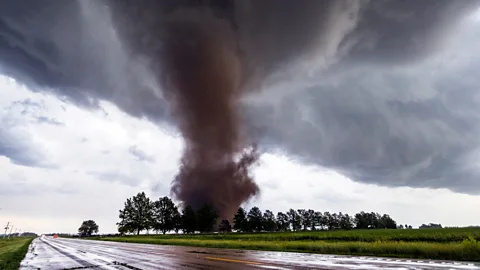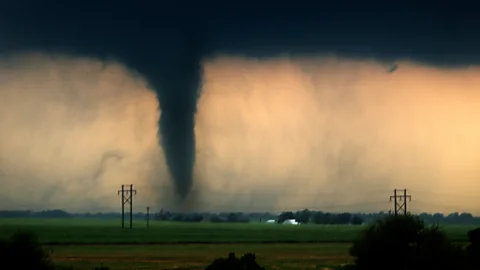You can't hear it, but this sound can reveal that a tornado is on its way
 Getty Images
Getty ImagesThe terrifying, destructive power of tornadoes is as sudden as it is violent. Now scientists are eavesdropping on twisters to develop new early warning systems and fight warning fatigue.
It begins with the rustling of leaves, sinister squeak of hinges and the creak of nearby trees. Then comes a deafening rumble like an approaching freight train, the terrifying screech of nails being ripped from wooden boards and unpredictable thuds from flying debris. These are the sounds often described by tornado survivors recounting their escape from these storms.
They rarely have much warning, but it is often enough to save lives.
There's another sound, however, that accompanies tornadoes that we can't hear. It is so low in frequency it is beyond the realms of human hearing, but it could offer a way of providing earlier, more accurate warnings of these destructive storms.
With winds that can reach up to 483km/h (300mph), the storms that produce tornadoes generate low frequency sound waves – or infrasound – that can travel for hundreds of miles.
Eavesdropping on these infrasound signals may not be able to prevent tornadoes from flattening towns and tossing cars into the air like toys, but it could lead to a new type of early warning system that might save lives.
Shaky predictions
Around 1,200 tornadoes leave trails of destruction in the US in an average year, with most occurring on the Great Plains of the central US. (Read about how tornado alley is changing.) They cause millions, and in some years, billions of dollars-worth of damage annually and claim an average of 87 lives a year since 1951 (although the number of fatalities varies wildly from year to year). According to the National Oceanic and Atmospheric Administration (Noaa), 76 people have died in around 1400 tornadoes in the US in 2023 so far. At least 26 people were killed in Mississippi when a unusually long-lived tornado damaged more than 2,000 homes along a 59 mile (94km) path. In December 2023, two people were killed – a mother and her two year old son – when several powerful tornadoes tore across Tennessee. Powerful storms that, included reports of tornadoes, swept through eastern Indiana and western Ohio on 14 March, leaving at least three people dead.
Yet twisters are notoriously difficult to forecast because we still don't have a clear picture of why they do and do not form. Even when they do form, the violent column of air behaves erratically.
For decades, meteorologists have struggled to identify which storms will produce tornadoes and which will not. Chris Nowotarski, associate professor in the department of atmospheric sciences at Texas A&M University says that while experts are "fairly good" at predicting the large-scale conditions that can produce tornadoes up to days in advance, predicting when and where specific tornadoes will form is more difficult. "Several storms that seem capable of producing a tornado might exist in the same favourable environment, but only one or two will actually produce a tornado," he says.
Most destructive tornadoes spawn from "supercells". These violent thunderstorms form from a persistent rotating updraught known as a mesocyclone that generates tall, anvil-shaped clouds and bring severe weather including heavy rain, high winds and large hailstones. When conditions are favourable, downdraughts within the supercell storm concentrate the rotating air into lower levels of the atmosphere. Eventually the rotating air becomes focused into a narrow column that when it reaches the ground becomes a tornado. But while there are many theories about what causes this to happen – such as temperature differences in the air on the outside of the storm – the exact conditions that cause a tornado to form are not fully understood.
The wind itself is also invisible to the human eye. They only become visible due to the presence of water vapour that condenses into a funnel shaped cloud within the vortex of the tornado, where the air pressure is lower, while dust and debris also help to make them visible.
Doppler radar can offer a way of spotting mesocyclones as they are forming as the water carried by these storms reflects the radar signal, but meteorologists are only rarely able to spot actual tornados using this technique. This can also mean the tornado warnings that rely upon this method can often turn out to be false alarms as the supercell thunderstorm detected using the radar don't ever produce a tornado, says Nowotarski. Often, storm spotters on the ground are needed to verify whether a tornado has formed.
"Many storms that appear 'primed' to produce a tornado never do so," says Nowotarski. "False alarms are problematic, because a tornado warning can be disruptive to special events, work, and everyday life. While not as disruptive as a tornado, too many 'boy who cried wolf' events will encourage the public to not take action in future warnings and be unprepared when a tornado actually does it."
Forecasters also tend to err on the side of caution when issuing warnings – understandable, as the consequences of not sheltering can be deadly. But false alarms lead to fatigue and can be particularly problematic in multi-hazard scenarios in which tornadoes occur within landfalling hurricanes or alongside flash flooding, says Nowotarski.
This has left forecasters looking for other ways to predict whether a tornado is on its way.
 Getty Images
Getty ImagesEavesdropping on tornadoes
Scientists have been listening to tornadoes and trying to work out whether they produce a unique sound since the 1970s. Experimental evidence suggests that low-frequency infrasound, with a frequency range of 1-10Hz , is produced while a tornado is taking shape and throughout its life. One recent set of measurements from a tornado near Lakin, Kansas in May 2020 revealed that the twister produced a distinct, elevated signal between 10Hz and 15Hz. In some cases arrays of infrasound detecting microphones have been shown to pick up the noise produced by tornadoes from more than 100km (60 miles) away and have also indicated that the infrasound is produced before tornadogenesis even begins.
Researchers hope that by eavesdropping on these noises, it may be possible to not only hear a tornado coming but perhaps even predict them up to two hours before they form.
Since 2020, a team from Oklahoma State University has been testing infrasound's predictive powers using equipment installed in tornado-chasing vehicles. Their portable kit, the Ground-based Local Infrasound Data Acquisition, or "Glinda", system, references a character from The Wizard of Oz. They hope the equipment will help storm chasers to better monitor the development of tornadoes in real time, but requires the equipment to be deployed to the right place at the right time.
Some researchers, however, are working on systems that can be left to permanently monitor for tornadoes. One group, led by Roger Waxler, principal scientist at the National Centre for Physical Acoustics (NCPA) based at the University of Mississippi, are planning to deploy four permanent arrays of high-tech sensors in south Mississippi to detect infrasound signals. They hope the system will provide a way of consistently monitoring and detecting tornadoes.
"Analysis of years of data collected during tornado seasons has left little doubt that tornadoes radiate an infrasonic signal that can be detected on an array of infrasound sensors and followed from great distances," says Waxler. "This gives us confidence that a tornado's path can be determined from simultaneous infrasonic detections on multiple arrays.”
The arrays he and his team are deploying should stay active for at least three tornado seasons, which they hope will enable them to analyse infrasound data in real time.
Waxler's team first gathered evidence to support their infrasound theory by using sensors originally designed to detect clandestine nuclear weapons tests. "They are considered state-of-the-art for detecting signals from extremely large explosions," he says.
After tornado outbreak struck Oklahoma in 2011, his team looked at data they collected and were able to track a particular tornado in an EF4 storm for 100 miles (161km). "In that case the tornado got close enough so that its signal got very loud," he says. They had initially started chasing the tornadoes and dropping sensors as close as they could get – something he admits was a "horrible idea" and led to his team developing fixed tornado-spotting arrays instead.
More recently, in 2020, the researchers used their sensor arrays in northern Alabama to detect almost every tornado that passed through the region.
One of the concerns about potential infrasound early warning systems is whether they will be able to distinguish between tornado signals and the general noise of a storm. But researchers say they can see a clear signal. "We even have one case where the nature of the signal changed, and we could see that the tornado was in the air," says Waxler. "It would be advantageous if we could distinguish when one was on the ground versus in the air."
There are more challenges to overcome. Wind noise can interfere with infrasound measurements and there is uncertainty about whether infrasound can reliably tell the difference between storm types. "One recent study suggests that tornadic and non-tornadic storms may produce very similar infrasound signatures, so the potential for using infrasound to home in on potential tornadoes may be limited," Nowotarski says.
 Getty Images
Getty ImagesWaxler says some sources of infrasound in storms such as thunder can be easily distinguished. "Thunder has different spectral characteristics [such as pulse interval, amplitude and wave length] – it's easy to tell that that's not a tornado," he says. But he admits that telling the difference between tornadoes and supercells that do not produce tornadoes presents a challenge. Some of that might be because some supercells are producing tornadoes but are not being spotted by eyewitnesses in a way that helps corroborate the infrasound signals. "We need more data," Waxler says.
Giving fair warning
But Waxler and his team hope their decade-long experiment will lead to an effective early warning system for tornadoes, particularly when combined with other sources such as doppler radar.
"It's not unreasonable that we could localise a tornado to half a football field," adds Waxler. "I envision seeing a map on an app with a dot that shows there's a tornado coming up South Lamar [Avenue, for example]."
Warnings have improved in recent decades: from 2003 to 2017, 87% of deadly tornadoes were preceded by an advance warning, but people still have an average of just 10-15 minutes to find shelter.
A study based on interviews with 23 survivors of two deadly tornadoes found that people tried to evaluate and respond to the risk of a tornado as the situation evolved, but some did not have a place to shelter easily. Experts believe tornado warnings are too often ignored due to "warning fatigue" created by false alarms and hours of televised storm coverage. One study found 37% of people surveyed did not understand the need for taking precautionary measures during a tornado warning.
Waxler hopes that a more accurate early warning system could change the way people respond when they hear a storm is approaching. "Rather than going to hide in your bathtub or cellar, it might be a better idea to get in your car and drive if you know where a tornado is. "The goal is to save lives."
--
